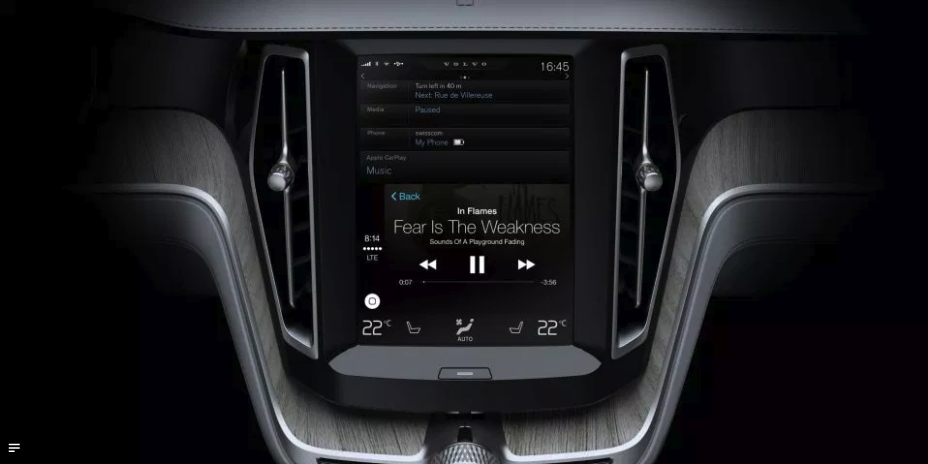Trends: Entertainment in the car has come a long way

Story by John LeBlanc
It seems almost as soon as the automobile became a way of everyday life in North America, car owners wanted to be entertained and informed while driving.
So-called “automotive infotainment” mostly started with the first in-car over-the-air broadcast radio receivers in the 1930s. The ability to receive news, sports and music while driving proved incredibly popular, with radio being the single choice for drivers until after World War II. But it wasn’t until the mid-1950s when America’s Motorola offered a form of a vinyl record player in some Chryslers when automotive infotainment offerings started to expand beyond the core AM-band radios.
While the AM (and eventually FM) radio receivers were still the car infotainment standard, with the explosion of pop music in the 1960s, car buyers started to demand the type of audio technologies in their vehicles found at home. First came onboard cassette and eight-track tape decks in the late-1960s, followed by compact disc (CD) players in the 1980s.
The introduction of the automotive CD player also prompted the demand for serious upgrades to in-car speaker systems. While a single dashboard speaker was good enough for the tinny music coming out of an AM radio, the high-quality output from an audio CD required multi-speaker sound systems, further enhanced by powerful onboard amplifiers. It’s now quite common to see high-end, home audio brands like Harman Kardon as standard equipment in some makes.
Even then, car (and now truck, minivan and crossover owners) weren’t happy simply getting their music, news, and sports while driving. The advent of in-car DVD players allowed movie watching while on the go, and new GPS (Global Positioning Systems) navigational systems made paper maps obsolete. And while DVD and nav systems were once the sole domain of high-end luxury vehicles, these technologies have now trickled down to cars at the low end of the market.
Of course, the introduction of Apple’s iPod portable music player in 2001 — and subsequently, the iPhone smartphone in 2007 — has forced more changes in the automotive infotainment field in the past decade than over the past 80 years combined.
Instead of relying on the tastes of a radio programming director, or the tapes and CDs you were able to bring along in your vehicle, iPod owners were able to access thousands of songs and customized playlists and play them through their car’s sound system. The change almost happened overnight, with automakers quickly adding iPod-compatible audio jacks and Universal Serial Bus (USB) jacks to their vehicles.
The proliferation of smartphones like the iPhone — and their ability to access the Internet via broadband networks, allowing for not only phone calls but also real-time navigation and texting — has only accelerated the revolution in automotive infotainment.
Today, automobiles are being designed from the start to allow these hand-held devices to connect to vehicles in a safe manner. USB ports and Bluetooth are becoming standard features, even at the lowest end of the new car market.
Automaker infotainment systems, like Ford’s SYNC, Kia’s UVO and General Motors’ MyLink, allow smartphone users to connect to their vehicle either wirelessly through Bluetooth or via USB connections. This connectivity allows drivers to keep their hands on the steering wheel and interact with their vehicle’s systems either through voice-recognition, dashboard digital displays, steering wheel controls or text-to-speech feedback. As well, drivers can now connect to music streaming services, like Pandora or Spotify, via their smartphones or through their car’s infotainment hardware.
If you haven’t been in the market for a new car in a few years, all of these recent automotive infotainment advances may seem overwhelming. But ironically, the next big wave of innovation is coming from outside the car.
Following the lead in the growth of portable consumer electric devices like the Apple iPad tablet, the future of automotive infotainment will be the ability to connect these devices to the outside world while in your car. In fact, it’s starting much sooner than later.
Many car buyers can’t wait years between vehicles to upgrade their automotive infotainment experience. But they can afford faster and more powerful handheld devices sooner, which is why the future is making your tablet your car’s infotainment centre.
For example, in the U.S., Germany’s Audi offers a pay-for-use 4G LTE (Fourth Generation / Long-Term Evolution) broadband wireless service with its new 2015 A3 sedan. This actually turns the A3 into a rolling Internet hub. And starting later this year, GM will be the first automaker to offer 4G LTE wireless services across all its brands, beginning with the Chevrolet Malibu sedan. Passengers will be able to connect as many as seven devices to the Chevy to surf the web or stream live video via GM’s existing OnStar system.




